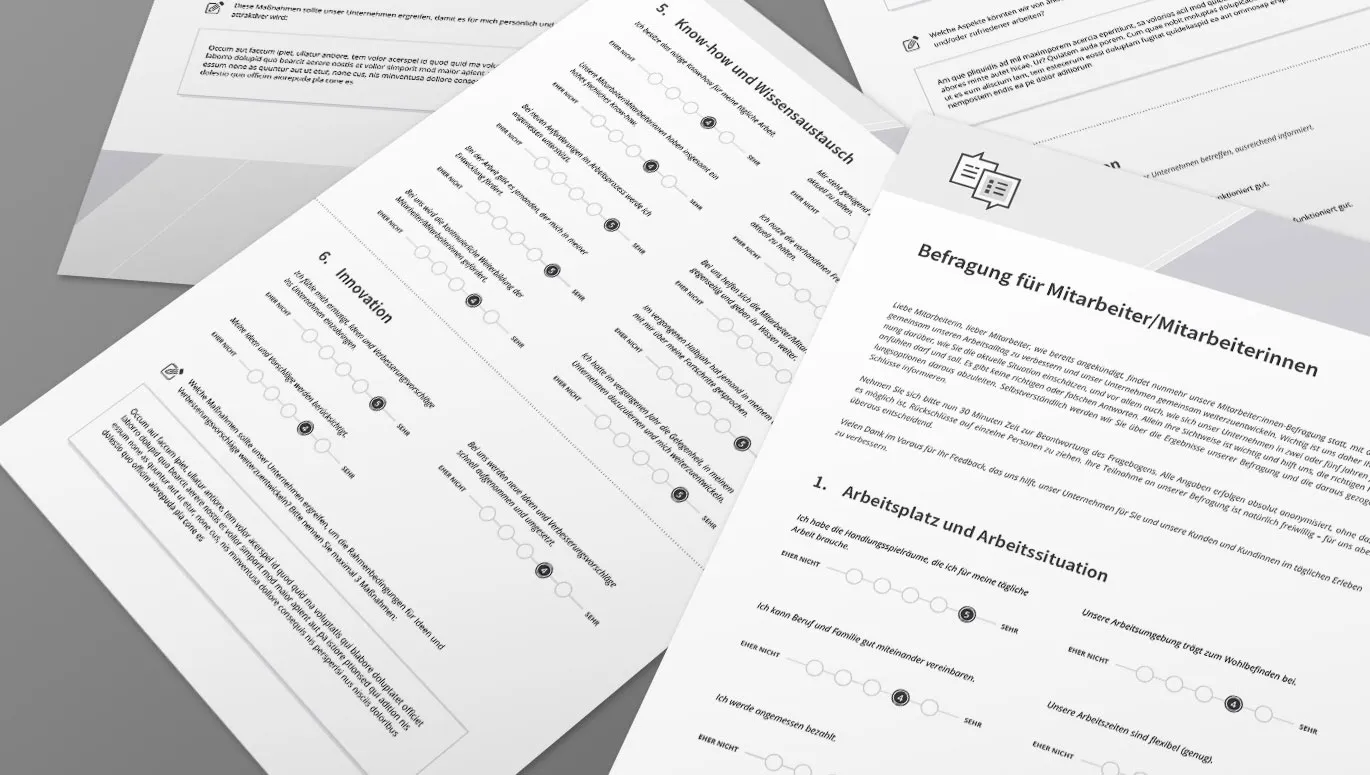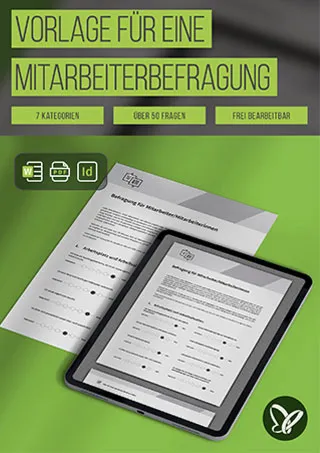Have you ever considered an employee survey? Voilà! We provide you with a free sample with 14 questions on the topics of workplace, work situation and communication for your employee survey. Simply download it at the end of the blog. But what would an employee survey blog be if we didn't tell you the best way to set it up? What is it all about? And why it is such a crucial tool for measuring the working atmosphere? The answers follow in our blog.
Employee survey? What is that?
More pay or less pressure to perform, more recognition or fewer working hours - all employees have their own wishes. But they usually don't come up with them on their own. And if you ask about it over a coffee break, the fear of saying the wrong thing can result in an empty phrase instead of an honest answer. The result: if wishes are left unsaid, they can quietly and secretly escalate into problems - and thus affect the productivity of your company and the attractiveness of your brand for potential new recruits.
The best antidote: an anonymous employee survey. It is the ideal tool for measuring the working atmosphere in your company. With questions on a wide range of topics, you can gather honest opinions and gauge the satisfaction of your team, for example. How well can your people fulfill their potential? How professionally do you act as a manager? What drives your team and what holds it back? The answers to these questions will show you where you score well as an employer - and where you should make improvements as soon as possible.
And because you conduct the employee survey anonymously, you counteract any false shyness and receive unbiased feedback including constructive criticism.
Incidentally, employee surveys have been a tried and tested means of measuring employee satisfaction for decades. Almost 80 years ago, such surveys provided important input in the USA, which resulted in improved working conditions and thus sparked economic growth. Today, more than half of all German companies use employee surveys as an effective tool against secret employee frustration.

The added value of the employee survey
If you are successful with your company - congratulations! In addition to your business vision, you probably also have a wonderful team that is helping you to grow.
To keep it that way, however, you should know how your employees are doing. What they think about the work processes, the work culture or the cooperation in the company. Or what they say about your company to their friends ... With an employee survey , you can delve into the depths of their employee mindset. You will receive answers from which you can derive concrete measures that will keep your existing team together - and attract new employees.
The benefits of an employee survey:
- You receive important input to counteract problems that are detrimental to the business at an early stage.
- You can increase the satisfaction and therefore the productivity of your crew.
- You can make the working experience more attractive.
- You show your people that you value them and take them seriously - especially if there are no regular employee appraisals due to the size of the company.
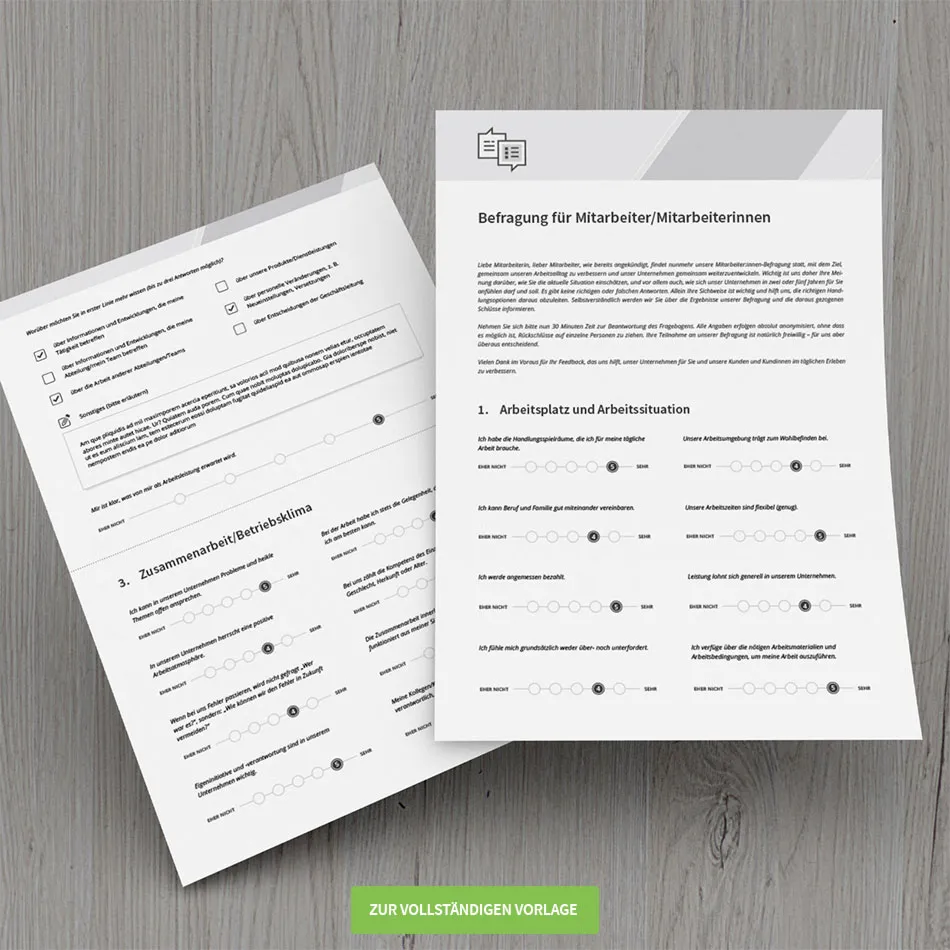
In focus: the satisfaction of your employees
Whether it's organizational culture, procedures within business processes, dealing with customers or their own commitment in the daily workflow - you can ask your employees about a wide variety of things.
The most important topic, however, is the satisfaction of your team. Above all, it determines how attractive you are or can become as an employer. The answers provide you with specific instructions on how you can optimize the environment and working conditions, knowledge transfer and work-life balance.
The employee satisfaction survey often comprises a good 60 questions. But the feedback is worth it. Because you get an accurate picture of your employees' motivation. You know why they want to stay with the company or not, how loyal they are to the company or not and why they like to work hard for you or not.
You should focus on these 6 core topics for the employee survey:
1. evaluating the workplace and work situation
These two areas play a decisive role in the satisfaction of your employees. Remuneration, adherence to working hours, work-life balance and workplace equipment all make a difference here.
2. communication in your company
Employees want to know where they stand, what you are planning for the future, what personnel developments are on the horizon, what new products or services you want to conquer the market with and what expectations are placed on each and every one of them. How well is your company doing in this respect? Ask about it!
3. cooperation and cohesion
Are all employees pulling in the same direction or is everyone cooking their own soup? Does everyone learn from mistakes together or are fingers pointed at the guilty parties? Is personal initiative encouraged? And what about fairness in terms of gender, age and origin?
How well cooperation works in the work process and beyond is a key factor in the satisfaction of your employees. It is the linchpin of the social fabric in your company.
4. the relationship between superiors and employees
Some managers use their power to their advantage, others don't mind a flat hierarchy. The report on the relationship between managers and employees is extremely important and probably says the most about why a company is on or off track. For employees, this involves such important questions as:
- Do my superiors value my work?
- Do I receive constructive feedback or am I just generally criticized?
- Does only my performance count or also my potential as a person?
- Are the hierarchies too high or too flat?
- What measures could improve the interaction between me and my superiors?
The answers are enormously exciting, because here you can question yourself as a manager 1:1.
5. the flow of ideas and suggestions
Can employees communicate suggestions for improvement without reservations? If so, how quickly are they taken into account? Exciting innovations can begin in an atmosphere of exchange and encouragement. What does it look like in your company? Your employees know the answers.
6 Know-how transfer and further training opportunities
Develop further or just carry on as usual? As we all know, stagnation is death. That's why access to new sources of knowledge is a very important fact for your team.
What training opportunities do you offer? Do you set aside a specific budget for this? Do employees have the opportunity to share their newly acquired knowledge with other colleagues - for example in the form of in-house presentations? Find out how your people feel about knowledge and education.
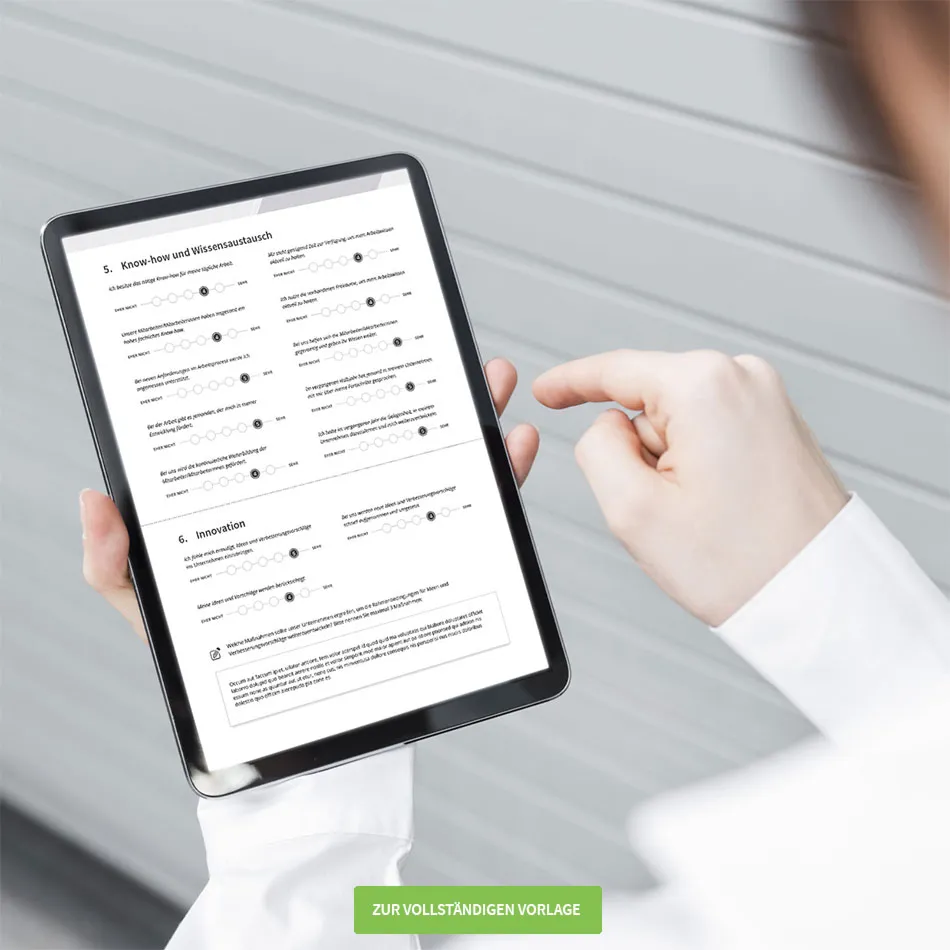
7 magic rules for a good employee survey
1. get your employees in the mood for the round of questions
When you suddenly ask your people a question, there will be a big question mark on their foreheads. They want to know why you are asking. Is something wrong? Is there a reason to worry about the job?
So tell them that you want to know how satisfied they are with their daily work and that you will use the answers to make things even better for everyone in the future. This way, your employees will realize in advance that you want to tackle something fundamental for them. With this realization, they will certainly provide you with well-founded facts instead of scribbled answers.
2. allow anonymous participation
With an anonymous survey, your employees feel much freer and are not afraid to answer uncomfortable questions truthfully. If you ask personalized questions instead, those involved may be worried that criticism of the company will be put on record.
Of course, you also need a sure instinct for anonymous questioning. After all, it may be possible to draw conclusions about individuals here too - for example, if you ask which department they work in and perhaps only two people work there. It is better not to ask such questions.
3. allow voluntary participation
Coercion diminishes trust. So let your employees decide for themselves whether they want to take part or not. Don't worry, they will do it out of their own interest, after all, they want you to initiate improvements for them.
4. ask more often
If you carry out an employee survey several times a year, the results will be clearer and closer to the action than if you only follow up once at the end of the year. In this case, your people will probably not review the whole year, but provide you with a snapshot.
Instead of initiating a one-off large survey with a lot of effort, you can split up the topics and spread them over the year in 2 or 3 rounds of questions.
5. rather ask specific questions
The more general you ask, the more general the answer you will get. Therefore, take the pulse of your employees with very specific questions. This also makes it easier for them to answer because they don't have to think long and hard about what the question covers.
6. provide possible answers
Formulating an answer to every question costs your employees valuable time. And filtering the findings during the subsequent evaluation also takes up a lot of your time. You can make things easier for yourself with specific guidelines:
- Work with rating scales: Do you want to know how satisfied your employees are with their salary? Here you can offer a scale from 1 to 5. Instead of a question, you can provide a statement - which is more personal to the employee in the first person.
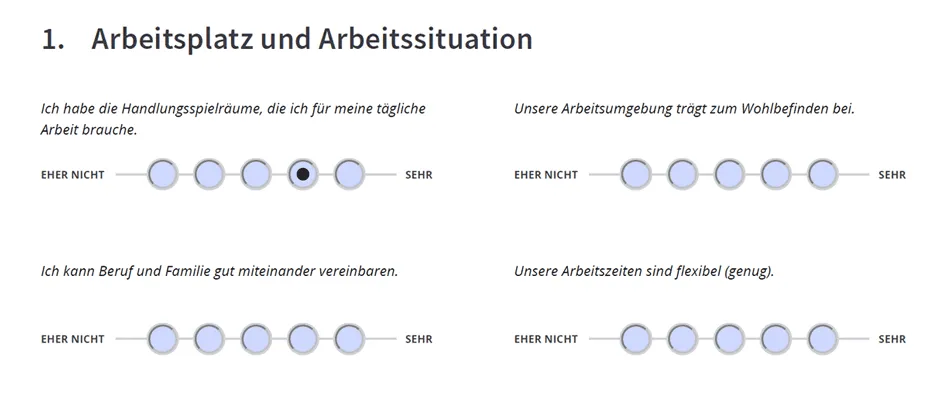
- Provide answers that cover a wider range: You want to know from your employees how the managers in your company act? Offer different scenarios to choose from. Like this:
... They are credible and live what they say
... show appropriate recognition for good work
... formulate clear goals and set priorities
... are open to ideas and suggestions
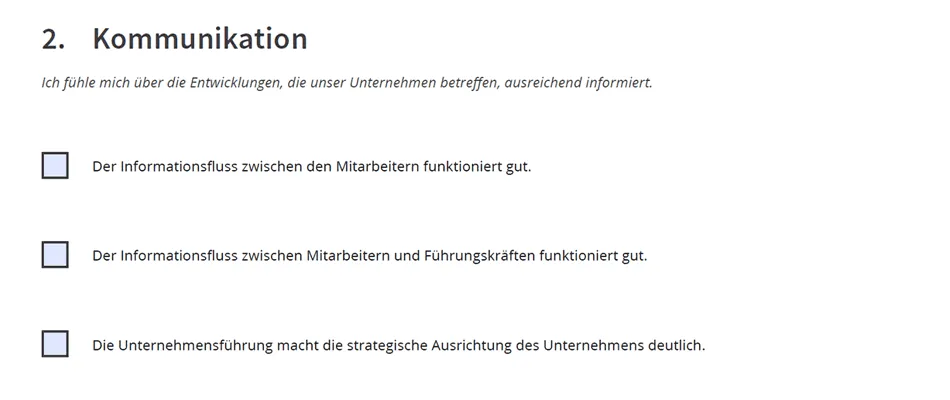
- Leave room for personal statements despite scales and selected answers: It is important that your employees can also say in their own words what they think is good or not so good. If something is on their mind, this is the place to get it off their chest. This way, you can focus on the positive options in your answers and don't have to offer negative examples to choose from. In addition, some questions can only be answered with a personal statement, for example when it comes to specific suggestions for improvement.

7. ask the right questions
Avoid putting answers into your employees' mouths. Ask factually and neutrally. You don't want your employees to just talk you down, you want them to freely express their opinions in order to make improvements possible.
- That's better: Do you also like our numerous training opportunities?
- That's better: How satisfied are you with our training opportunities?
Summarized questions can also prove to be a stumbling block. It's better to ask two individual, easy-to-understand questions than just one with two possible answers at the end.
- So rather not: How satisfied are you with the commitment of the management and the performance of your team leader?
- This is better: How satisfied are you with the commitment of the management?
- Or like this: How satisfied are you with the performance of your team leader?
The reason: While the management may shine in the eyes of the employee, the team leader may come off badly.
Free sample to download
With the input from this blog, you now have a solid basis for starting your own employee survey. You probably already have a lot of questions in mind that you want to ask your people.
To make it even easier for you, we have created a free template with 14 questions on the topics of workplace, work situation and communication for your employee survey . Simply download it and get started.
We wish you a rich set of answers - with which you can measure the satisfaction of your employees and increase it for the future.
Complete employee survey template for Word, InDesign, as a PDF and Google form
We make it easy for you to create your employee survey: the complete and tried-and-tested template is available for download at TutKit.com.
- Over 50 questions in seven categories (satisfaction, work situation, communication, working atmosphere, leadership, knowledge sharing, innovation)
- interactive templates for Word, as a Google form and PDF
- Fully customizable in Word, InDesign and Google Forms
- with prepared answer fields and checkboxes to fill in
Click here to download the complete questionnaire template with your Premium or Business membership.
